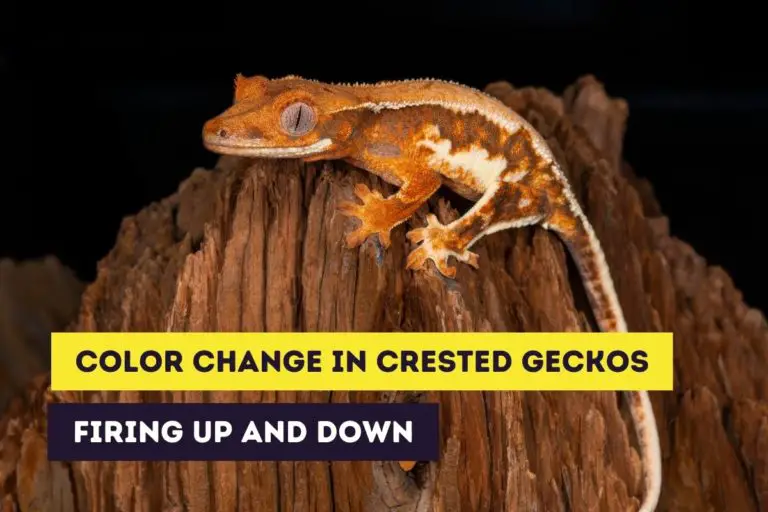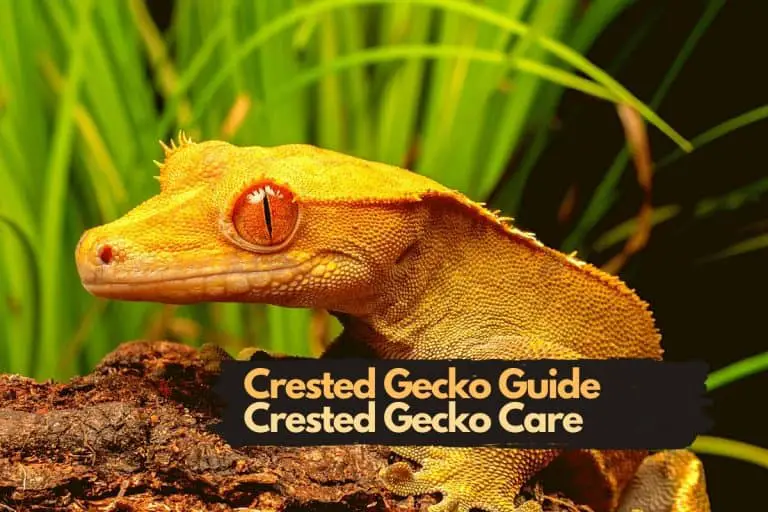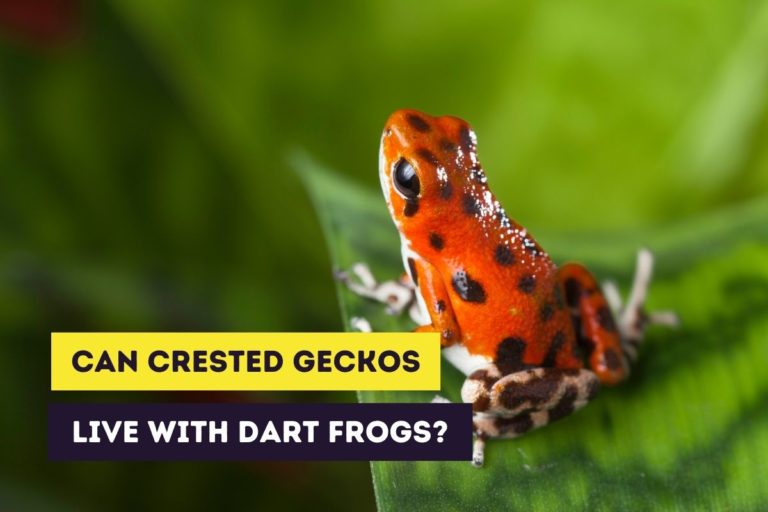Can Crested Geckos Live With Leopard Geckos?
Estimated reading time: 6 minutes
Crested geckos aren’t communal animals and can be held as solitary pets. You can house multiple females together and even keep a male and several females. But if you’re a real reptile enthusiast, you also might own a leopard gecko. But can crested geckos live with leopard geckos?
Crested geckos can’t be housed together with leopard geckos. They come from very different regions. The temperature and humidity needs of the terrarium will be different. Most importantly, creating a balance between the needs may hurt both gecko species.
Some videos on Youtube and some forum posts will tell you otherwise. But it can be hazardous for the health of your crested gecko and leopard gecko to put them together in one terrarium.
If you’re interested in stickers or other products of crested geckos, you can always visit our Etsy Shop, which is called Artful Animalia. We currently only send stickers in the United States. If you’re interested in certain crested gecko-related products, don’t hesitate to contact us.
This site contains affiliate links to products we recommend and use ourselves. We may receive a commission for purchases that you make through these links. If you’re interested in learning more about our affiliate links, please visit our (affiliate) disclaimer.
Crested Geckos and Leopard Geckos
Crested geckos come from a very different part of the world than leopard geckos. It’s important to understand that although they’re from the same gecko family, crested geckos and leopard geckos are very different.
The most important reasons why they shouldn’t be held together are differences in:
- natural habitat
- temperature needs
- humidity needs
- dietary needs
Natural Habitat
Crested geckos live in the forests of New Caledonia and are arboreal; this means that they live most of their life in the trees and foliage. Therefore, you will not see many crested geckos spending time on the ground.
On the other hand, leopard geckos can be found in Afghanistan, Iraq, Iran, and parts of India. They can be found in arid and semiarid regions. They live on the ground and hide from the intense heat during the day. Just as crested geckos, they’re nocturnal and will come out to forage and hunt at night.
Although both geckos are nocturnal, one is arboreal, and the other is terrestrial. This necessitates a different type of terrarium. Typically a crested gecko terrarium is a vertical terrarium with many plants and branches. On the other hand, a leopard gecko terrarium is a horizontal terrarium with no need for many plants and branches.
For this reason, you might want to choose separate housing for both geckos.
Temperature
Crested geckos can’t tolerate the high temperatures and prefer the same temperatures as most humans. They prefer temperatures in the high 70s degrees Fahrenheit (about 24 to 27 degrees Celsius) when they’re awake and active. They need even lower temperatures at night when they sleep and are inactive. Then they need a temperature in the high 60s or low 70s degrees Fahrenheit (20 to 22 degrees Celsius).
They should never be exposed to temperatures over 85 degrees Fahrenheit (29 degrees Celsius) unless they can retreat to a much cooler area in the terrarium.
Leopard geckos need a high temperature to function right. They need a temperature of about 80 to 85 degrees Fahrenheit (27 to 29 degrees Celsius). The temperature should never be hotter than 90 degrees Fahrenheit (32 degrees Celsius) because the leopard gecko may dehydrate. The temperature should also not be cooler than 80 degrees Fahrenheit (27 degrees Celsius) or they may not be able to digest their food.
Humidity
Crested geckos live in a high humidity environment and they need high humidity to shed their skin and stay healthy. The ideal humidity ranges from 60 to 80 percent, although they probably can tolerate higher humidity levels if the terrarium is appropriately ventilated.
Leopard geckos, on the contrary, are desert animals and are not adapted to high humidity levels. They prefer a humidity level between 30 and 40 percent. While they do need higher humidity to shed appropriately, they don’t want the terrarium to be too high all the time.
So while you can probably create some balance between the proper humidity for your crested gecko and the right humidity for your leopard gecko, it will be complicated. In addition, you’re at a real risk of harming both pets’ health just to put them in the same terrarium.
Diet
Crested geckos are omnivorous and eat both insects and fruits in the wild. In captivity, they will mostly be fed meal replacement powders with the occasional insect and fruit as a treat from time to time.
Leopard geckos mostly eat insects in the wild and will be fed crickets, mealworms, and waxworms in captivity. There are also commercial diets available, but they’re different from those provided to crested geckos.
Of course, you can try to fix this issue by feeding them separately and just sticking to commercial diets for both geckos. But many leopard gecko owners want to provide just crickets and worms. This may cause harm to the crested gecko. Your crestie might become obese and you’ll need to balance the diet of your crested gecko, so it gets all nutrients necessary.
Are Leopard Geckos Territorial?
Crested geckos aren’t that territorial – at least the females aren’t. A terrarium can contain multiple female cresties. You can even house a male and several female crested geckos together. The males can be territorial and fight with each other. So it’s not a good idea to keep multiple male crested geckos together.
The same goes for leopard geckos. Male leopard geckos can be very territorial and fight with each other. It’s for that reason never a good idea to put multiple males together. Putting multiple females together can be possible.
Since crested geckos are smaller than leopard geckos there is a real risk that the leopard gecko will fight or bully the smaller crested gecko (also see related questions).
Bottom Line
If you’re still on the fence and can’t decide on keeping both gecko species together, let me advise you not to.
It will be stressful for both geckos and they won’t be happy and healthy. There is a risk that your geckos will fight and bite each other. And – since he has a thin skin – your crested gecko has a higher chance of being injured.
If you haven’t got a gecko, research which one is the best for you. If you already have a crested gecko or leopard gecko and want the other one, just house them in a different terrarium that’s best suited for them.
Related Questions
Will a leopard gecko attack a crested gecko?
Both geckos are strangers to each other in the wild. While leopard geckos mostly stick to insects as food, but they may see the crested gecko as prey since it’s a lot smaller.
In the wild, leopard geckos sometimes eat smaller lizards if they get the chance. So it’s a risk for your crestie. Besides that, they can have a nasty bite because a crested gecko doesn’t have tough skin. This will cause injuries and stress – possibly tail loss – for your crested gecko.
Can’t I just get a large enough terrarium so both won’t be in contact with each other?
You could potentially have a colossal terrarium, but it should be the size of an entire room. If it were possible to create such a terrarium, I advise you not to put a leopard gecko and a crested gecko together in such a terrarium. If you want to mix several gecko species, you should try to place animals of the same habitat and region together.
Want to Learn More?
If you want to learn more about crested geckos as pets, please read the following articles.
If you’re interested in getting crested geckos as pets you should also definitely read our article about baby and juvenile crested gecko care or (adult) crested gecko care.
If you want to learn more about leopard geckos as pets, please visit this amazing YouTube channel “Leopard Gecko”.







